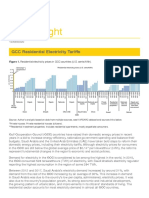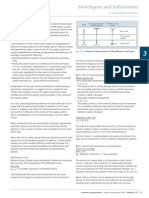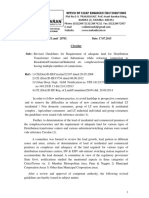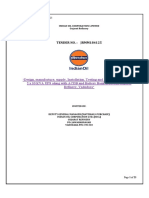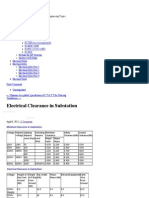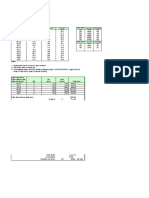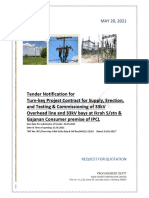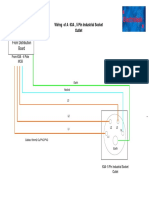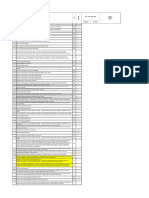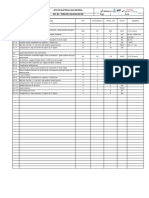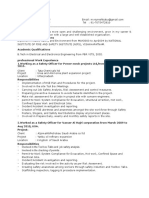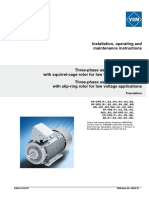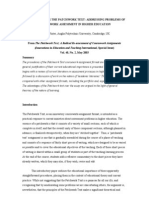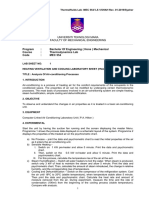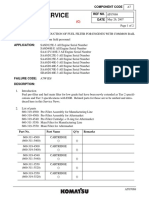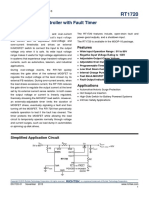There are no standards governing load schedules and therefore this calculation is based on
generally accepted industry practice. The following methodology assumes that the load schedule
is being created for the first time and is also biased towards industrial plants. The basic steps for
creating a load schedule are:
Step 1: Collect a list of the expected electrical loads in the facility
Step 2: For each load, collect the electrical parameters, e.g. nominal / absorbed
ratings, power factor, efficiency, etc
Step 3: Classify each of the loads in terms of switchboard location, load duty and load
criticality
Step 4: For each load, calculate the expected consumed load
Step 5: For each switchboard and the overall system, calculate operating, peak and
design load
Step 1: Collect list of loads
The first step is to gather a list of all the electrical loads that will be supplied by the power
system affected by the load schedule. There are generally two types of loads that need to
be collected:
Process loads - are the loads that are directly relevant to the facility. In factories and
industrial plants, process loads are the motors, heaters, compressors, conveyors, etc
that form the main business of the plant. Process loads can normally be found on
either Mechanical Equipment Lists or Process and Instrumentation Diagrams (P&ID's).
Non-process loads - are the auxiliary loads that are necessary to run the facility, e.g.
lighting, HVAC, utility systems (power and water), DCS/PLC control systems, fire
safety systems, etc. These loads are usually taken from a number of sources, for
example HVAC engineers, instruments, telecoms and control systems engineers,
safety engineers, etc. Some loads such as lighting, UPS, power generation auxiliaries,
etc need to be estimated by the electrical engineer.
Step 2: Collect electrical load parameters
A number of electrical load parameters are necessary to construct the load schedule:
Rated power is the full load or nameplate rating of the load and represents the
maximum continuous power output of the load. For motor loads, the rated power
corresponds to the standard motor size (e.g. 11kW, 37kW, 75kW, etc). For load items
that contain sub-loads (e.g. distribution boards, package equipment, etc), the rated
power is typically the maximum power output of the item (i.e. with all its sub-loads in
service).
Absorbed power is the expected power that will be drawn by the load. Most loads
will not operate at its rated capacity, but at a lower point. For example, absorbed
motor loads are based on the mechanical power input to the shaft of the driven
equipment at its duty point. The motor is typically sized so that the rated capacity of
the motor exceeds the expected absorbed load by some conservative design margin.
Where information regarding the absorbed loads is not available, then a load factor of
between 0.8 and 0.9 is normally applied.
Power factor of the load is necessary to determine the reactive components of the
load schedule. Normally the load power factor at full load is used, but the power
factor at the duty point can also be used for increased accuracy. Where power factors
are not readily available, then estimates can be used (typically 0.85 for motor loads
>7.5kW, 1.0 for heater loads and 0.8 for all other loads).
Efficiency accounts for the losses incurred when converting electrical energy to
mechanical energy (or whatever type of energy the load outputs). Some of the
electrical power drawn by the load is lost, usually in the form of heat to the ambient
environment. Where information regarding efficiencies is not available, then estimates
of between 0.8 and 1 can be used (typically 0.85 or 0.9 is used when efficiencies are
unknown).
Step 3: Classify the loads
Once the loads have been identified, they need to be classified accordingly:
Voltage Level
What voltage level and which switchboard should the load be located? Large loads may need to
be on MV or HV switchboards depending on the size of the load and how many voltage levels are
available. Typically, loads <150kW tend to be on the LV system (400V - 690V), loads between
�150kW and 10MW tend to be on an intermediate MV system (3.3kV - 6.6kV) where available and
loads >10MW are usually on the HV distribution system (11kV - 33kV). Some consideration
should also be made for grouping the loads on a switchboard in terms of sub-facilities, areas or
sub-systems (e.g. a switchboard for the compression train sub-system or the drying area).
Load duty
Loads are classified according to their duty as either continuous, intermittent and standby loads:
1) Continuous loads are those that normally operate continuously over a 24 hour period,
e.g. process loads, control systems, lighting and small power distribution boards, UPS
systems, etc
2) Intermittent loads that only operate a fraction of a 24 hour period, e.g. intermittent
pumps and process loads, automatic doors and gates, etc
3) Standby loads are those that are on standby or rarely operate under normal
conditions, e.g. standby loads, emergency systems, etc
Note that for redundant loads (e.g. 2 x 100% duty / standby motors), one is
usually classified as continuous and the other classified as standby. This if purely
for the purposes of the load schedule and does not reflect the actual operating
conditions of the loads, i.e. both redundant loads will be equally used even though
one is classified as a standby load.
Load criticality
Loads are typically classified as either normal, essential and critical:
1) Normal loads are those that run under normal operating conditions, e.g. main process
loads, normal lighting and small power, ordinary office and workshop loads, etc
2) Essential loads are those necessary under emergency conditions, when the main
power supply is disconnected and the system is being supported by an emergency
generator, e.g. emergency lighting, key process loads that operate during emergency
conditions, fire and safety systems, etc
3) Critical are those critical for the operation of safety systems and for facilitating or
assisting evacuation from the plant, and would normally be supplied from a UPS or
battery system, e.g. safety-critical shutdown systems, escape lighting, etc
�Step 4: Calculate consumed load
The consumed load is the quantity of electrical power that the load is expected to consume. For
each load, calculate the consumed active and reactive loading, derived as follows:
Where
is the consumed active load (kW)
is the consumed reactive load (kVAr)
is the absorbed load (kW)
is the load efficiency (pu)
is the load power factor (pu)
Notice that the loads have been categorised into three columns depending on
their load duty (continuous, intermittent or standby). This is done in order to
make it visually easier to see the load duty and more importantly, to make it
easier to sum the loads according to their duty (e.g. sum of all continuous loads),
which is necessary to calculate the operating, peak and design loads.
Step 5: Calculate operating, peak and design loads
Many organisations / clients have their own distinct method for calculating
operating, peak and design loads, but a generic method is presented as follows:
Operating load
The operating load is the expected load during normal operation. The operating
load is calculated as follows:
Where
is the operating load (kW or kVAr)
�is the sum of all continuous loads (kW or kVAr)
is the sum of all intermittent loads (kW or kVAr)
Peak load
The peak load is the expected maximum load during normal operation.
Peak loading is typically infrequent and of short duration, occurring
when standby loads are operated (e.g. for changeover of redundant
machines, testing of safety equipment, etc). The peak load is calculated
as the larger of either:
or
Where
is the peak load (kW or kVAr)
is the sum of all continuous loads (kW or kVAr)
is the sum of all intermittent loads (kW or kVAr)
is the sum of all standby loads (kW or kVAr)
is the largest standby load (kW or kVAr)
Design load
The design load is the load to be used for the design for equipment sizing, electrical studies, etc.
The design load is generically calculated as the larger of either:
or
Where
is the design load (kW or kVAr)
�is the operating load (kW or kVAr)
is the sum of all standby loads (kW or kVAr)
is the largest standby load (kW or kVAr)
The design load includes a margin for any errors in load estimation, load growth
or the addition of unforeseen loads that may appear after the design phase. The
load schedule is thus more conservative and robust to errors. On the other hand
however, equipment is often over-sized as a result. Sometimes the design load is
not calculated and the peak load is used for design purposes.
Step 1: Collect list of loads
Consider a small facility with the following loads identified:
2 x 100% vapour recovery compressors (process)
2 x 100% recirculation pumps (process)
1 x 100% sump pump (process)
2 x 50% firewater pumps (safety)
1 x 100% HVAC unit (HVAC)
1 x 100% AC UPS system (electrical)
1 x Normal lighting distribution board (electrical)
1 x Essential lighting distribution board (electrical)
Step 2: Collect electrical load parameters
The following electrical load parameters were collected for the loads identified in Step 1:
Load Description
Abs. Load
Rated Load
PF
Eff.
Vapour recovery compressor A
750kW
800kW
0.87
0.95
Vapour recovery compressor B
750kW
800kW
0.87
0.95
Recirculation pump A
31kW
37kW
0.83
0.86
Recirculation pump B
31kW
37kW
0.83
0.86
�Sump pump
9kW
11kW
0.81
0.83
Firewater pump A
65kW
75kW
0.88
0.88
Firewater pump B
65kW
75kW
0.88
0.88
HVAC unit
80kW
90kW
0.85
0.9
AC UPS System
9kW
12kW
0.85
0.9
Normal lighting distribution board
7kW
10kW
0.8
0.9
Essential lighting distribution board
4kW
5kW
0.8
0.9
Step 3: Classify the loads
Suppose we have two voltage levels, 6.6kV and 415V. The loads can be classified as
follows:
Load Description
Rated Load
Voltage
Duty
Criticality
Vapour recovery compressor A
800kW
6.6kV
Continuous
Normal
Vapour recovery compressor B
800kW
6.6kV
Standby
Normal
Recirculation pump A
37kW
415V
Continuous
Normal
Recirculation pump B
37kW
415V
Standby
Normal
Sump pump
11kW
415V
Intermittent
Normal
Firewater pump A
75kW
415V
Standby
Essential
Firewater pump B
75kW
415V
Standby
Essential
HVAC unit
90kW
415V
Continuous
Normal
AC UPS System
12kW
415V
Continuous
Critical
Normal lighting distribution board
10kW
415V
Continuous
Normal
Essential lighting distribution board
5kW
415V
Continuous
Essential
Step 4: Calculate consumed load
Calculating the consumed loads for each of the loads in this example gives:
Continuous
Load Description
Abs
Load
PF
Eff.
Vapour recovery
compressor A
750kW
0.8
7
Vapour recovery
750kW
0.8
Intermittent
Standby
P
(kW)
Q
(kVAr)
P
(kW)
Q
(kVAr)
P
(kW)
Q
(kVAr)
0.9
5
789.5
447.4
0.9
789.5
447.4
�compressor B
Recirculation
pump A
31kW
0.8
3
0.8
6
36.0
24.2
Recirculation
pump B
31kW
0.8
3
0.8
6
36.0
24.2
Sump pump
9kW
0.8
1
0.8
3
10.8
7.9
Firewater pump A
65kW
0.8
8
0.8
8
73.9
39.9
Firewater pump B
65kW
0.8
8
0.8
8
73.9
39.9
HVAC unit
80kW
0.8
5
0.9
88.9
55.1
AC UPS System
9kW
0.8
5
0.9
10.0
6.2
Normal lighting
distribution board
7kW
0.8
0.9
7.8
5.8
Essential lighting
distribution board
4kW
0.8
0.9
4.4
3.3
936.6
542.0
10.8
7.9
973.3
551.4
SUM TOTAL
Step 5: Calculate operating, peak and design loads
The operating, peak and design loads are calculated as follows:
P (kW)
Q (kW)
Sum of continuous loads
936.6
542.0
50% x Sum of intermittent loads
5.4
4.0
10% x Sum of standby loads
97.3
55.1
Largest standby load
789.5
447.4
Operating load
942
546.0
Peak load
1,731.5
993.4
Design load
1,825.7
1,047.9




